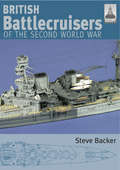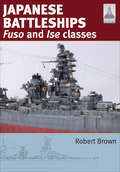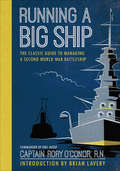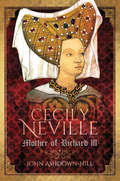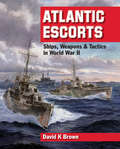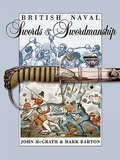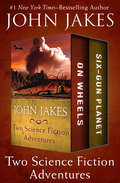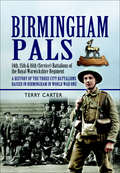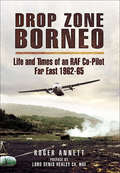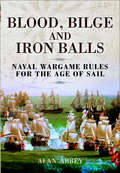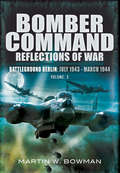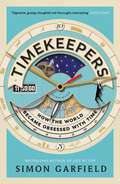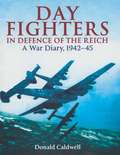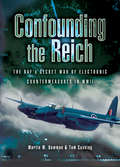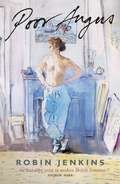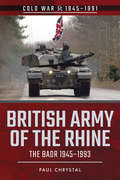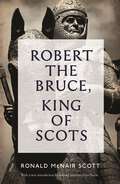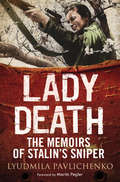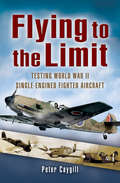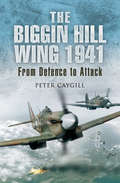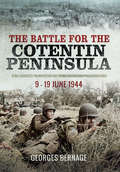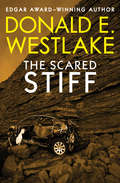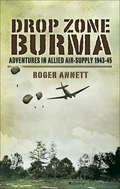- Table View
- List View
British Battlecruisers of the Second World War
by Steve BackerThe 'ShipCraft' series provides in-depth information about building and modifying model kits of famous warship types. Lavishly illustrated, each book takes the modeller through a brief history of the subject class, highlighting differences between sisterships and changes in their appearance over their careers. This includes paint schemes and camouflage, featuring colour profiles and highly-detailed line drawings and scale plans. The modelling section reviews the strengths and weaknesses of available kits, lists commercial accessory sets for super-detailing of the ships, and provides hints on modifying and improving the basic kit. This is followed by an extensive photographic survey of selected high-quality models in a variety of scales, and the book concludes with a section on research references—books, monographs, large-scale plans and relevant websites. The latest in this series covers the three ships of this First World War type, Hood, Repulse and Renown, which survived to fight in the Second. Still the fastest capital ships in the world in 1939, their protection was not up to contemporary standards and two were famously lost in action. Hood in an old-fashioned gunnery duel, but Repulse succumbed to the more modern threat of aerial attack. The one modernised ship, Renown, survived an adventurous wartime career.
Japanese Battleships: Fuso & Ise Classes (ShipCraft #24)
by Robert BrownThis fully illustrated guide offers historical context and step-by-step instruction for building and modifying Japanese battleship models. This volume in the ShipCraft series covers the two related classes of Japanese 14in-gunned battleships, originally built during the First World War but subsequently reconstructed. These ships are famous for their towering forward superstructure, usually described as a pagoda bridge, that they featured when rebuilt. The Ise-class ships underwent further reconstruction during the Second World War to emerge as a unique hybrid of battleship and aircraft carrier to compensate for fleet carriers sunk earlier in the war. This lavishly illustrated guide takes readers through a brief history of the Fuso-class and Ise-class ships, highlighting differences between sisterships and changes in their appearance over their careers. It features color profiles of paint schemes as well as detailed line drawings and scale plans. The modelling section reviews the strengths and weaknesses of available kits, lists commercial accessory sets for super-detailing, and provides hints on modifying and improving the basic kit. This volume also includes a photographic survey of selected high-quality models in a variety of scales and a section on further research references
Running a Big Ship: The Classic Guide to Commanding A Second World War Battleship
by Rory O'ConorThe ultimate officers&’ guide from the commander of the HMS Hood. &“A fascinating historical record . . . a first-class textbook for modern managers&” (Baird Maritime). Published in 1937 and now recognized as one of the most influential, yet highly accessible, volumes on naval command and organization, Running a Big Ship provides truly unique insight into life at sea during the Second World War. O&’Conor famously commenced the book with his &“ten commandments,&” a concise code of orders that comprise &“a little that everyone must know.&” The main body of the book sets out each of the duties required of a Royal Navy Officer in detailed, clear terms with O&’Conor&’s insightful advice. Such knowledge ranges from tips on the issuing and execution of orders to attendance requirements, the treatment of defaulters and shipboard theft, midshipmen training, ceremonies, uniforms, cleanliness aboard ship, and the management of the Fleet Air Arm and the high-speed service boats. There are fascinating observations and explanations of the finer points of bugle calls, the treatment of guests, and complete instructions for many forms of recreation from cinema to regattas. Credited with making a significant contribution to the wartime navy&’s esprit de corps, the book had a lasting impact on shipboard understanding and relations for vessels large and small as young, diverse crews withstood the considerable strain of actual war. Running a Big Ship truly sets us below decks and at sea during World War II and includes an extensive introduction by one of the foremost historians of the Royal Navy, Brian Lavery.
Cecily Neville: Mother of Richard III
by John Ashdown-HillAn intriguing new biography of the fifteenth-century Duchess of York and mother to two kings of England. Wife to Richard, Duke of York, mother to Edward IV and Richard III, and aunt to the famous Kingmaker, Richard, Earl of Warwick, Cecily Neville was a key player on the political stage of fifteenth-century England. She is rumored to have been known as the Rose of Raby because of her beauty and her birth at Raby Castle, and as Proud Cis because of her vanity and fiery temper, But Cecily&’s personality and temperament have actually been highly speculated upon. In fact, much of her life is shrouded in mystery. Aside from Cecily&’s role as mother and wife, who was she really? Matriarch of the York dynasty, she navigated through a tumultuous period and lived to see the birth of the future Henry VIII. From seeing the house of York defeat their Lancastrian cousins; to witnessing the defeat of her own son, Richard III, at the battle of Bosworth, Cecily then saw one of her granddaughters become Henry VII&’s queen consort. Her story is full of controversy, and the few published books on her life are full of guesswork. In this highly original history, Dr. John Ashdown-Hill—renowned for his role in locating the long-lost remains of Richard III in 2012—seeks to dispel the myths surrounding Cecily using previously unexamined contemporary sources. Includes illustrations
Atlantic Escorts: Ships, Weapons & Tactics in World War II
by David K. Brown&“Altogether, a very detailed year-by-year account of escort development for anti-submarine work from the period between the wars to post World War II.&” —The Nautical Magazine Winston Churchill famously claimed that the submarine war in the Atlantic was the only campaign of the Second World War that really frightened him. If the lifeline to North America had been cut, Britain would never have survived; there could have been no build-up of US and Commonwealth forces, no D-Day landings, and no victory in western Europe. Furthermore, the battle raged from the first day of the war until the final German surrender, making it the longest and arguably hardest-fought campaign of the whole war. The ships, technology and tactics employed by the Allies form the subject of this book. Beginning with the lessons apparently learned from the First World War, the author outlines inter-war developments in technology and training, and describes the later preparations for the second global conflict. When the war came the balance of advantage was to see-saw between U-boats and escorts, with new weapons and sensors introduced at a rapid rate. For the defending navies, the prime requirement was numbers, and the most pressing problem was to improve capability without sacrificing simplicity and speed of construction. The author analyses the resulting designs of sloops, frigates, corvettes and destroyer escorts and attempts to determine their relative effectiveness.&“Atlantic Escorts has flowed from the pen of a master who has written so many fine books about the history of ship construction. It is a small masterpiece.&” —Warship International Fleet Review
British Naval Swords and Swordmanship
by Mark Barton John McGrathThis new publication is intended to bring together a mass of research dealing with all aspects of British naval swords. Unlike the much sought after Swords of Sea Service by May and Annis, this work offers a far broader coverage and, for the first time, the complete story of swords and swordsmanship is presented in one concise volume. While the swords themselves are described the authors also tell the story of naval swordsmanship For exsample, subjects such as how swords and cutlasses were used in action and how training was conducted and covered. The authors also address how how the use of swords developed into a sport in the Navy, and how swords and swordsmanship may have entered naval symbology in such areas as ships' names. Many current myths are addressed and corrected, and the story is brought right up to date with information on the sport from 1948 to 2000. While the book concentrates on the Royal Navy, foreign weapons, including those of the Irish Naval Service, are mentioned where appropriate Other British Maritime organisations such as the Merchant Navy, the Customs and Coastguard Services, and the Reserves are also addressed The book also covers subjects such as dating, collecting, and conservation of swords and re-examines those swords attributed to Nelson. The Appendices include the first list of Swords of Peace awarded to naval units to be published. Recent research by the authors is also reflected in the updated lists of Patriotic Fund Awards, City of London Swords, and Naval fencing champions contained in the Appendicitises The comprehensive nature of the work has not been attempted before and the book will appeal to a wide range of naval enthusiasts and historians, collectors of weapons, fencers and re-enactors.
Two Science Fiction Adventures: On Wheels * Six-Gun Planet
by John JakesTwo visions of the world gone mad, from master storyteller John JakesIn On Wheels, the United States has become so overpopulated that a tenth of its people have no home. Instead, they spend their lives on the highway. With all of the dangers of the road, dropping below forty miles per hour would mean certain death—even for men like Billy Spoiler. The clans of the open road spend their lives battling each other for control of the freeway, and the Spoilers are no exception. They never give up, never pull over, and never take their hand off the throttle. On the colony world of Six-Gun Planet, cowboys ride robot horses. In an effort to escape the corrupting influence of technology, the people of this strange, isolated world they call Missouri have reset the clock to 1880, building a civilization of main streets, saloons, and bordellos, where it is always high noon. Reluctant gunslinger Zak Randolf thinks the whole set-up is ridiculous, but he goes along with it because there&’s good money in playing the part of a western hero. When notorious gunslinger Buffalo Yung challenges him to a duel, though, Zak gets serious. Missouri&’s horses may be fake, but its bullets are definitely real. This ebook bundle features an illustrated biography of John Jakes including rare images from the author&’s personal collection.
Birmingham Pals: 14th, 15th & 16th (Service) Battalions of the Royal Warwickshire Regiment, A History of the Three City Battalions Raised in Birmingham in World War One (Pals Ser.)
by Terry CarterIn the summer of 1914, our finest young men flocked to the colors in Northern towns and cities to answer Lord Kitcheners Call to Arms in a spontaneous burst of enthusiasm and patriotism. The Call appealed to their sense of adventure and offered an escape from the humdrum life of office, factory and mill.The new recruits volunteered with brothers, cousins, friends and work mates. The newly formed units became the focus of local civic pride and soon became known as the Pals. The City of Birmingham formed three such battalions with over 3,000 local volunteers. This book tells their story.Birmingham Pals is a story that covers the full range of human experience in war—the highest courage and bravery, the misery and tedium of trench life, the exhilaration, terror and slaughter involved in going over the top. Above all, it is a story of interest to people of all backgrounds and ages, as a tale of comradeship, which, for many survivors, was to last a life time.
Drop Zone Borneo: Life and Times of an RAF Co-Pilot Far East, 1962-65
by Roger AnnettIn 1963 the Indonesian Army that threatened Borneo numbered 330,000 men, plus three thousand Commandos. Of these, six thousand were within 20 miles of the Borneo frontier. This grew to thirteen thousand in early 1965. From mid-way through 1964, British troops and their allies who were defending the border started to make offensive incursions into Indonesian Borneo—these operations were codenamed "Claret". Taken into account the confrontational nature of the campaign, casualties sustained in Borneo were surprisingly light. That in the whole of the Borneo campaign there were no fatalities among the RAF supply-dropping transports was extraordinary. The border area between the Indonesian and Malaysian parts of Borneo was one of the most inaccessible areas of mountainous jungle anywhere in the world—an entire army was kept supplied in the field for the complete campaign. This is the exciting account from a pilot who flew the dangerous flying missions and relates the tenseness and stresses of Jungle life in those dangerous days.
Blood, Bilge and Iron Balls: Naval Wargame Rules for the Age of Sail
by Alan AbbeyBlood, Bilge and Iron Balls is a set of wargame rules for naval battles in the age of sail. With them you can recreate the triumphs of Nelson or Hawke or tackle pirates on the Spanish Main. The rules themselves are very simple and easy to learn. Each player can easily command a single ship or several, the rules working equally well for a single frigate chasing down a privateer, or a large-scale fleet action with multiple players on each side. The basic rules have been written with the emphasis on providing a fast-playing and fun game, but optional rules are included which will add a greater level of historical realism and detail. A unique card-driven turn sequence prevents the game becoming too predictable. Also included are a selection of scenarios for re-fighting specific historical battles and simple campaign rules. Although intended for use with model ships, the rule book includes sheets of ship counters which can be used to get started. Just add dice, tape measure and pencil and you're ready to play.
Bomber Command: Battleground Berlin, July 1943–March 1944 (Bomber Command)
by Martin W. BowmanThis massive work provides a comprehensive insight to the experiences of Bomber Commands pilots and aircrew throughout World War Two. From the early wartime years when the RAFs first attempts to avenge Germanys onslaught were bedeviled by poor navigation and inaccurate bombing, to the final winning onslaught that finally tamed Hitler in his Berlin lair, these volumes trace the true experiences of the men who flew the bombers. Hundreds of first-hand accounts are punctuated by the authors background information that put each narrative into wartime perspective. Every aspect of Bomber Commands operational duties are covered; day and night bombing, precision low-level strikes, mass raids and operations throughout all wartime theaters. Contributions are from RAF personnel who flew the commands different aircraft from the early Blenheims and Stirlings to the later Lancasters and Mosquitoes. Each volume is full of accounts that tell of the camaraderie amongst the crews, moments of sheer terror and the stoic humor that provided the critical bond. The five volumes of this work provide the most vivid and comprehensive work on the outstanding part played by RAF Bomber Command in their vital role in the destruction of the Third Reich.
Timekeepers: How the World Became Obsessed with Time
by Simon GarfieldBy the bestselling author of Just My Type: a &“thoroughly enjoyable and illuminating&” journey into the concept of time &“stuffed with fascinating material&” (Observer, UK).Timekeepers is a book about our obsession with time and our desire to measure it, control it, sell it, film it, perform it, immortalize it and make it meaningful. In this fascinating, anecdotal exploration, award-winning author Simon Garfield has two simple intentions: to tell some illuminating stories, and to ask whether we have all gone completely nuts. Here, Garfield explores the nature of time through stories such as: the Beatles learning to be brilliant in an hour and a half; an Englishman arriving back from Calcutta, refusing to adjust his watch; Beethoven&’s symphonic wishes being ignored; a US Senator&’s speech that goes for 25 hours; the horrors of war frozen at the click of a camera; a woman who designs a ten-hour clock and reinvents the calendar; Roger Bannister living out the same four minutes over a lifetime; and a who prince attempts to stop time in its tracks.&“Digressive, gossipy, thoughtful and thoroughly entertaining.&”—The Sunday Times, UK
Day Fighters in Defence of the Reich: A Way Diary, 1942–45
by Donald CaldwellA day-by-day account of Nazi air operations in WWII by the coauthor of The Luftwaffe over Germany, winner of an Air Force Historical Foundation Award. Day Fighters in Defence of the Reich is a detailed, comprehensive daily reference to the air operations flown by the Luftwaffe. During the Second World War, German air defenses struggled to cope with the threat posed by the American 8th and 15th Air Forces, which were charged with destroying Germany&’s critical war industries and wresting control of the air over the Reich from the Luftwaffe. This unique volume includes a brief narrative and a table of statistics detailing every mission of every Luftwaffe unit defending the Greater German Reich or the western occupied zone against strategic raids by the USAAF; tables of monthly sorties, losses and victory claims by the USAAF and the Luftwaffe over the Reich and the western occupied zone; and combat accounts by Luftwaffe pilots. This &“tremendous piece of work,&” is based on documents in the German, American and British government archives and German pilot logbooks and interviews from the author&’s extensive collection (Aeroplane Magazine). Caldwell is well known for his balanced presentations and the clarity of his writing. This book is a must-have for anyone with a serious interest in World War II aviation history. &“Highly recommended, and quite likely to be remembered as one of the most important new books of the year.&”—Stone & Stone &“Such a staggering quantity of information would be overwhelming in less capable hands. But Caldwell spices up his tight narrative with excellent photos and informative captions.&”—Aviation History
Confounding the Reich: The RAF's Secret War of Electronic Countermeasures in WWII
by Martin W. Bowman Tom CushingA history of the British RAF’s 100 Group—the airmen, ground crew, and technicians—who supported the Strategic Bomber Offensive during World War II.On 23 November 1943, 100 (Bomber Support) Group of RAF Bomber Command was formed. The object was to consolidate the various squadrons and units that had been fighting a secret war of electronics and radar countermeasures, attempting to reduce the losses of the heavy bombers—and their hard-pressed crews—in Bomber Command. This secret war involved the use of air and ground radars, homing and jamming equipment, special radio and navigational aids, and intruding night-fighters to seek out and destroy their opposite numbers: the Ju 88s and Bf 110s of the Nachtjagdgeschwader who defended the night skies of the Third Reich with ever increasing success. The book contains many first-hand accounts from pilots and crew and provides a fascinating record of 100 Group’s wartime history.
Poor Angus
by Robin Jenkins&“A blackly comic romp&” of art, ambition, and sexual politics in the Scottish Isles: &“a remarkable novel…written with the lightest of touches&” (The Sunday Times, UK). Struggling painter Angus McAllister has returned to the idyllic Hebridean island of his birth in the hope that it will inspire him to create his masterpiece. But soon, his privacy is invaded by Janet, a visitor with relatives on the island, who has decided that an affair with an artist would be the simplest way to incense and recapture her husband, a golf-fanatic devoid of imagination. So begins an irresistible story of comic lightness and serious implications; a tale told with Jenkins&’s characteristic ironic wit that explores the attitudes of men and women to sex and relationships, and which focuses on the psychology of the artist and the justification, if any, for art.&“Poor Angus is a strange, wonderful love story [and] Jenkins a remarkable writer whose gentlest touch induces the greatest of pleasures.&”—The Times, UK
British Railways A C Electric Locomotives: A Pictorial Guide
by David CableThe genesis of 25kv overhead electrification began in the late 1960s on the West Coast Main Line, the 1980s for the East Anglian Main Line, and the East Coast Main Line in the late 1980s. Development took place in stages culminating in fully electrified lines from London to Scotland on both East and West Coast lines, and from London to Norwich. The introduction of these lines required the construction of new motive power.Initially five types were produced for the WCML, from which the second phase of loco design was developed, giving a higher level of reliability, as well as power output. These newer designs were applied to the Anglian services, but the ECML plans required an updated design, ostensibly for mixed traffic, but hardly ever used on anything other than express passenger services, for which their 140mph potential enabled a major recast of the timetable. The opening of the Channel Tunnel required a mixed traffic dual voltage locomotive, running on both 25kv and the Southern Region 750v third rail DC.The locomotives are classified between 81 and 92 inclusive, and this book of photographs by David Cable covers all the classes in a variety of locations and duties.
British Army of the Rhine: The BAOR, 1945–1993 (Cold War, 1945–1991)
by Paul ChrystalThe nervous geopolitical tension between East and West, the Cold War, emerged before the end of the Second World War and lasted until 1991 with the collapse of the Soviet Union. The British Army of the Rhine was born in 1945 out of the British Liberation Army at the close of the war as the military government of the British zone of occupied Germany. As the Soviet threat increased, so BAOR became less of an occupational army and assumed the role of defender of Western Europe, and as a major contributor to NATO after 1949.This book traces and examines the changing role of BAOR from 1945 to its demise in the 1993 Options for Change defence cuts. It looks at the part it played in the defence of West Germany, its effectiveness as a Cold War deterrent, the garrisons and capabilities, logistics and infrastructure, its arms and armour, the nuclear option and the lives of the thousands of families living on the front line.
Robert the Bruce, King of Scots: King of Scots
by Ronald McNair Scott&“A heroic biography of one of Scotland's legendary leaders, by a British novelist and former literary critic for the London Sunday Times&” (Kirkus). Robert the Bruce had himself crowned King of Scots at Scone on a frozen March morning in 1306. After years of struggle, Scotland had been reduced to a vassal state by Edward I of England. Its people lived in abject poverty. But on the day he seized the crown, Bruce renewed the fight for Scotland&’s freedom, and let forth a battle cry that would echo through the centuries. Using contemporary accounts, Ronald McNair Scott tells the story of Scotland&’s legendary 14th century leader, and one of Europe&’s most remarkable medieval kings. From Bruce&’s historic victory against England in the Battle of Bannockburn to the day in 1324 when the Pope recognized him as king of an independent Scotland, this is a story of a man whose life shaped a nation.&“A thundering good narrative … splendidly told.&”—Sunday Telegraph, UK
Lady Death: The Memoirs of Stalin's Sniper
by Lyudmila PavlichenkoThe memoir of Lyudmila Pavlichenko, the Russian woman who was WWII&’s most accomplished sniper—and a friend of Eleanor Roosevelt.In June 1941, when Hitler launched Operation Barbarossa, Lyudmila Pavlichenko left her university studies, ignored the offer of a position as a nurse, and became one of Soviet Russia&’s two thousand female snipers. Less than a year later, she had 309 recorded kills, including 29 enemy sniper kills. By the time she was withdrawn from active duty due to injury, she was regarded as a key heroic figure for the war effort.To continue serving the war effort, Pavlichenko spoke at rallies in Canada and the United States. She toured the White House with FDR, and the folk singer Woody Guthrie wrote a song, &“Miss Pavlichenko,&” about her exploits. An advocate for women&’s rights, she befriended Eleanor Roosevelt and toured England to raise money for the Red Army. Never returning to combat, Pavlichenko trained other snipers. After the war, she finished her education at Kiev University and began a career as a historian. Today, she remains a revered hero in Russia, where the 2015 film, Battle for Sevastopol, was made about her life.
Flying to the Limit: Testing World War II Single-engined Fighter Aircraft
by Peter CaygillThe author of Javelin from the Cockpit looks at some of the more notable British, German, and American fighters through performance and handling trials. During the years preceding and during WW2, the RAF and the Royal Aircraft Establishment were responsible for the selection and procurement of British military aircraft and also to evaluate their capabilities against captured enemy models whenever possible. During the lend-lease agreement with the USA, the RAF and Fleet Air Arm operated several American designs, each of which was tested to evaluate its potential. This book looks at the key area of fighter aircraft and includes the test results and pilot&’s own first-hand accounts of flying seventeen different models, designed in the UK, America and Germany. The reader will learn of the possibilities of air superiority offered by these types and also their weaknesses. Types included are The Hawker Hurricane, Supermarine Spitfire, Boulton Paul Defiant, Hawker Tempest and Typhoon, Bell Airacobra, Messerschmitt Bf 109, Focke-Wulf Fw 190, Brewster Buffalo, Curtiss Tomahawk, North American Mustang, Grumman Martlet, Republic Thunderbolt, and Vought Corsair. All aircraft that saw a great deal of action throughout the War and which are now part of legend.
Words of Advice: A Novel
by Fay WeldonA weekend in the country goes awry in Fay Weldon&’s wickedly entertaining novel of lust, avarice, and murder Nineteen-year-old Elsa is poor in material goods, but rich in looks. Her employer and lover, forty-four-year-old Victor, used to be a tax accountant. Now he&’s an antique dealer who gave up his family for Elsa, and together they live in a room behind his shop. For her birthday, Victor is treating Elsa to a weekend in the country, courtesy of his rich friends, Hamish and his wheelchair-bound wife, Gemma, who mistakes Elsa for Victor&’s daughter. Not the most propitious way to start the weekend. Things go from bad to worse when Gemma starts treating Elsa like a home wrecker and Victor proposes a partner swap. Elsa is about to discover the darker side of &“happily ever after&” in this story about love, life, and fairy tales that never come true.
The Biggin Hill Wing, 1941: From Defence to Attack
by Peter CaygillAn in-depth study of England&’s most famous fighter station during the year of the Battle of Britain. The Biggin Hill Wing, 1941 looks at the political upheaval within Fighter Command that saw the removal of Sir Hugh Dowding and Keith Park and their replacement by Sir William Sholto Douglas and Trafford Leigh-Mallory. The ongoing Big Wing controversy and the resulting change in tactics during 1941 are examined. The main part of the book is a chronological account of the squadrons of the Biggin Hill Wing, with particular emphasis on the pilots. The units covered include No.s 66, 72, 74, 92, 124, and 609 Spitfire Squadrons and 264 Defiant Night Fighter Squadron. The author&’s research is based on combat reports and squadron Operation Record Books as well as firsthand accounts written by the participant pilots in the battles over southern England and northern France. Extensive appendices include Air Combat Claims of the Wing, Operational Aircraft Losses, Details of Selected Operations, and The Great Escape, which recounts the marked influence of ex-Biggin Hill pilots on the escape from Stalag Luft III in 1944.
The Battle for Cotentin Peninsula: 9–19 June 1944
by Georges BernageIn June 1944, the Americans left the Sainte-Mre-Eglise and Utah Beach bridgehead and crossed the Merderet river to the Chausse de la Fiere, taking Picauville on 10 June. Their advance was slowed following the failure of the 90th Infantry Division, but they were able to take Pont-l'Abbe on 12 June and Saint-Sauveur-le-Vicomte 16 June. Two days later they cut the Cotentin peninsula at Barneville, before heading north towards Cherbourg.As well as authentic eyewitness testimony, the book also acts as a field guide, including maps and both contemporary and modern photographs.
The Scared Stiff
by Donald E. WestlakeA couple&’s insurance scam could turn a faked death into a real one, in this witty crime thriller by the Edgar Award–winning author of the Dortmunder novels. After more than a decade of skipping out on their debts, Lola and Barry owe a lot of money to the wrong people. To escape the loan sharks, Barry decides it&’s time for one of them to die—or at least to pretend to. As the venue for this insurance fraud, they choose Lola&’s home country, Guerrera, where death certificates come cheap and government record-keeping is sketchy at best. There is only one problem: la familia. After Barry&’s &“death,&” Lola returns to the US, leaving her husband in the hands of her family as he begins to assume her brother&’s identity. But the South-American hospitality of Lola&’s relatives soon wears thin as they realize that their lives might be easier if Barry&’s death weren&’t just an act. Conning an insurance company is tricky enough, but no matter the country, no one is more dangerous than the in-laws.
Drop Zone Burma: Adventures in Allied Air-Supply, 1943–45
by Roger AnnettAir-dropped supplies were a vital part of the Allied campaign in Burma during World War II. The transportation of munitions, food and medical supplies was undertaken in the most difficult situations, both on the land where the air bases were often situated in remote tropical jungle terrain and in the air when hazardous flying conditions were met in the steamy airs above the carpet of forest treetops.This book is based upon the memories of nine veterans of the campaign: John Hart, an air-dispatcher with 194 Squadron; Peter Bray, a Dakota pilot with 31 Squadron; Arthur Watts, a fitter with both 31 and 194 Squadrons; Colin Lynch an Observer on 31 Squadron; Norman Currell, a Dakota pilot with 31 Squadron; George Hufflett, 1st Queens Infantry; Ken Brown, Royal Signals; Eric Knowles, the Buffs and Dame Vera Lynn who was with ENSA during the campaign. It describes how they arrived in Burma and their previous wartime experiences and then explains there parts in the famous actions such as The Defence of Arakan, The Sieges of Imphal and Kohima, the Allied Counterattack, the Advance to Mandalay and the Race to Rangoon.The author explains the background to this theater of war and then puts the veterans memories into context as the campaign progresses.
